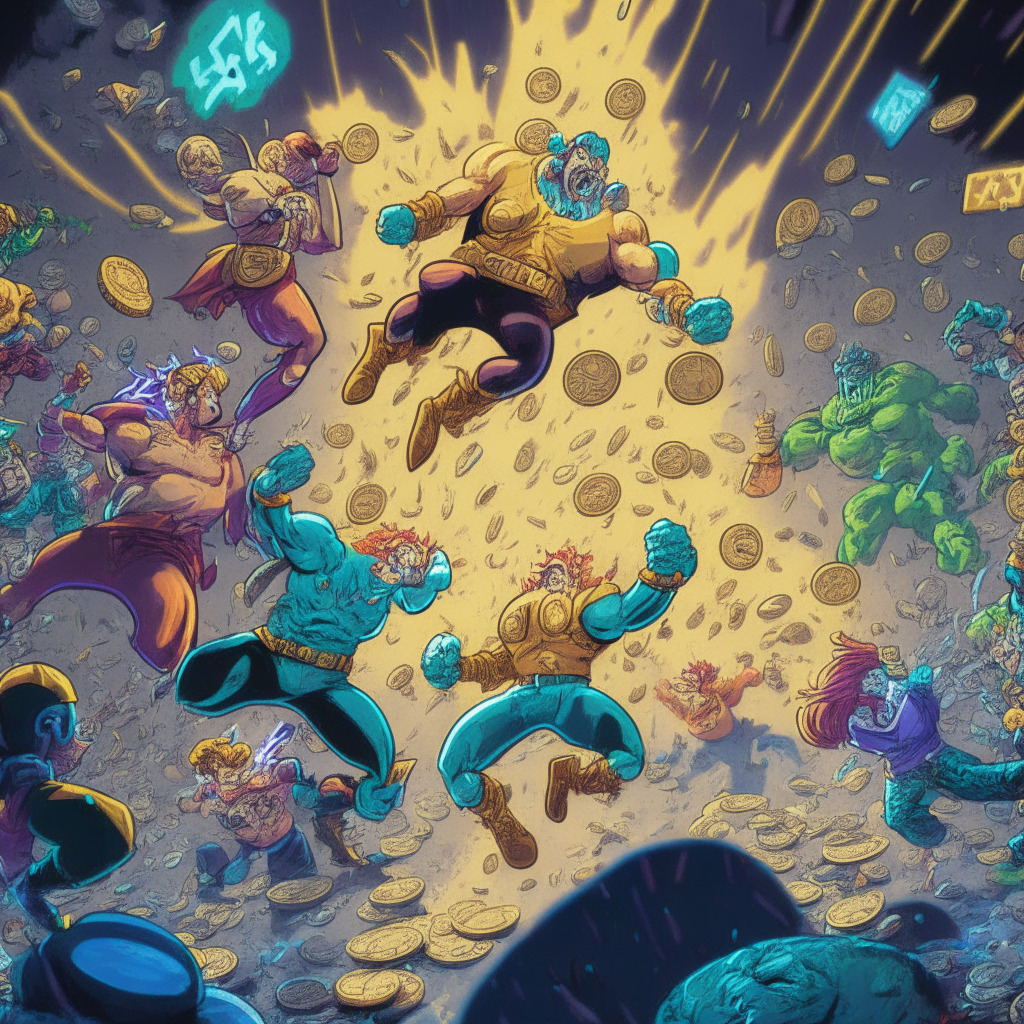Celsius is transferring 428,015 stETH ($781 million) from liquid staking platform Lido, possibly in preparation for withdrawal. This move could enable Celsius to stake directly without Lido’s intermediary role, increasing profits but also exposing them to potential security risks and impacting Lido’s staking dominance.
Search Results for: staked ether
Lido Unlocks ETH Withdrawals: Analyzing $500K Movement and Legal Implications for Liquid Staking
Lido recently enabled Ether withdrawals for the first time, with over 260 stETH redeemed within the first three hours. Lido is a liquid staking derivatives protocol, allowing ETH holders to stake coins and earn rewards. The ETH withdrawal feature marks a positive milestone for liquid staking, but unresolved legal issues and potential increased regulatory oversight may cause hesitation among users.
Unlocking DeFi Liquidity: Time-Bound Tokens Revolutionize Locked Assets Trading
Crypto startup Hourglass launches the first-ever marketplace for trading Time-Bound Tokens (TBTs), allowing users to gain liquidity from locked-up assets in DeFi protocols. By selling the rights to the time duration in a secondary market, Hourglass aims to address liquidity challenges faced by users with lengthy withdrawal wait times.
Reduced ETH Staking Withdrawal Time: Boosting Liquidity or Pressuring Prices?
Binance recently announced a reduction in ETH Staking withdrawal processing time from 15 to 5 days, aiming to increase user satisfaction and adoption. Concerns arise about accelerated withdrawals potentially impacting ETH price. The overall effect on the market and ETH’s price remains uncertain.
MakerDAO’s Spark Protocol: Revolutionizing DeFi Lending or Risky Venture? Pros and Cons Unpacked
MakerDAO announces Spark Protocol, a lending marketplace for DAI users, offering competitive interest rates and increased liquidity options. Despite potential benefits, DeFi faces risks including scalability, security, and regulation, urging the community to weigh risks against potential benefits.
Liquid Staking vs DEXs: Battle for TVL Dominance in the DeFi Space
In the swiftly-evolving world of decentralized finance (DeFi), a significant shift has occurred: liquid staking […]
Shiba Inu (SHIB) on the Rebound: October Surge or Market Mirage? BTCMTX in Focus
“Shiba Inu (SHIB) has seen a minor uptick despite recent losses, with analysts suggesting a potential recovery rally. However, falling buyer interest indicates more challenges ahead. On the brighter side, the newly minted Bitcoin Minetrix (BTCMTX) offers potential with its tokenized cloud mining platform, allowing investors to earn by staking tokens.”
Cryptocurrency Showdown: SOL’s Resilience Amidst Leadership Scandal vs BTCMTX’s Rapid Growth
“SOL has shown resilience despite a slight price dip, growing by 21% within a week and 130% since year-start. Future growth is expected, indicated by its relative strength index rebound. FTX’s $1.2 billion SOL holdings create responsibility, but fears of a massive sell-off are reduced as these are mostly staked or locked.”
Navigating the Decline of ApeCoin and the Rise of Meme Kombat: A Shift in the Crypto Landscape
“ApeCoin (APE) has seen an 8% fall, continuing a 9-month slump due to unsettled conditions in the Bored Ape Yacht Club (BYAC) ecosystem and a 78% drop in NFT floor price. Meanwhile, Meme Kombat, a decentralized Web3 platform combines gaming and GambleFi, offering a lucrative ecosystem with a potential 112% APY.”
Unleashing the Meme Kombat Revolution: Merging Gaming, Meme Coins and Gambling
“Meme Kombat, a new platform in the crypto world, aims to combine gaming, meme coins and gambling. It stands out for offering rewarding staking programs and by integrating wealth accumulation with gaming fun. A crucial feature is its audited security, yielding no significant issues.”
AstroPepeX and TG.Casino – Disruptive Trends Gaining Traction in Cryptosphere
“AstroPepeX (APX), an AI-based token automation system, has seen a surge in trader interest, with market price increasing by +22.89% within 24 hours. APX uses AI to analyze over 10,000 ERC-20 tokens, providing an accessible platform for developers. Despite short-term volatility, experts predict a promising future for APX, especially with growing support for AI token deployments.”
Bitcoin vs. Bitcoin Minetrix: A New Contender in the Crypto Mining Arena
“Bitcoin Minetrix ($BTCMTX), offers a decentralized mining solution based on cloud computing where stakers earn credits for Bitcoin mining. Utilizing Ethereum’s secured smart contract platform, it helps reduce costs and automatically manages user allocations. Despite the enticing benefits, potential investors must consider market state and the ever-evolving crypto landscape.”
LUNC’s Potential Comeback Vs New Entrant Meme Kombat: Steering Through the Crypto Wake
Terra Luna Classic (LUNC) saw a 9% leap after sanctioning proposals to strengthen its position and its stablecoin, USTC. However, LUNC’s overall performance has been inconsistent. Despite market indicators suggesting a potential rally, LUNC’s year-long depreciation cannot be ignored. Meanwhile, a new presale token, Meme Kombat (MK) offers additional investment opportunities.
Mark Cuban’s $870,000 Loss: A Cautionary Tale Against Crypto Phishing Scams
Dallas Maverick owner, Mark Cuban, lost approximately $870,000 in various tokens due to a phishing attack. Phishing attacks in the crypto industry mislead users into exposing sensitive information or downloading malicious software, leading to significant financial losses. A counterfeit MetaMask wallet application initiated the fraud. Users are advised to exercise extreme caution, verify sources and conduct due diligence to avoid such incidents.
Decentralized Stablecoins: The Future Star or Centralization Roadblock of the Crypto Market?
Rune Christensen, co-founder of DeFi pioneer MakerDAO, foresees decentralized stablecoins dominating the crypto market while centralized ones may have the function of connectors with the traditional financial system. In the rapidly changing cryptocurrency landscape, regulation-friendly procedures and addressing centralization issues are critical in leveraging the potential of decentralized stablecoins.
Lido Enlists Cosmos Projects in a Liquid Staking Shift: A Blockchain Tsunami or a Centralization Risk?
“Lido, a significant player in the Ether staking landscape, collaborates with projects from the Cosmos blockchain ecosystem, indicating growing interest in liquid staking. With $16 billion in derivatives, liquid staking has become a major strategy for digital asset investors, providing inter-chain transaction opportunities and increased liquidity while also raising concerns about centralization.”
Manta Network’s Leap Forward: Gains and Regulatory Risks in Layer 2 Solutions
“Manta Network has launched its zero-knowledge proof layer 2 scaling network, an innovative platform for ZK-enabled DApp development. This introduces increased throughput and reduced gas fees, promising future DApps realm expansion. However, challenges and regulatory issues, as highlighted by the Celsius incident, suggest the need for careful navigation in blockchain tech.”
Lido Finance and the ERC-20 Security Flaw: Navigating Uncertain Waters in Crypto Safety
Despite a known security flaw in its token contract, Ethereum staking protocol Lido Finance ensures the safety of Lido DAO (LDO) and staked-Ether (stETH) tokens. The flaw reportedly allows “fake deposit” attacks, deviating from the usual Ethereum standards. The issue arises when a transfer’s value exceeds user holdings, generating a false positive rather than stopping the transaction. While this brings uncertainty, it’s a reminder for thorough testing before integrating new tokens.
Navigating Binance’s Controversial Actions: Million Dollar Refunds and Rug Pulls Fallout
“Binance plans to refund 887 users who were unable to redeem their staked CYBER tokens due to borrowing by opportunistic traders during a liquidity crunch. The compensation includes 800,000 USDT and 871 CYBER in staking rewards, along with 200,000 USDT worth of vouchers from CyberConnect Foundation. The incident has led to a discussion on better safeguards and decision-making processes in crypto exchanges.”
Exploring Tamadoge’s Strategic Token Burn Scheme and its Impact on $TAMA’s Value
Web3 games platform Tamadoge initiates a burn program to enhance the scarcity and value of its $TAMA token, aiming to curb circulating supply. The program employs three methods: Mega Burns, Community Burns, and Platform Revenue Burns, and is accompanied by promotional events. The company also introduced token staking with a pool of two million $TAMA tokens as rewards. They’re also focusing on building brand awareness while retaining their gaming user acquisition strategy.
Whale Losses: A $24 Million Lesson in Crypto Security and Lingering Vulnerabilities
“A large cryptocurrency investor recently lost $24 million, including Lido Staked ETH and Rocket Pool ETH, due to a phishing attack. This incident underscores questions about security in cryptocurrency ecosystem. It also emphasizes the need for caution when approving ERC-20 allowances and the importance of ongoing development of security measures within the crypto industry.”
Bridging the DeFi-CeFi Gap: Changex Paves New Paths or Mirrors Old Systems?
“Changex, labeled as Web3’s Swiss Army knife of personal finance, merges crypto trading and lending with traditional banking, embodying the concept of centralized and decentralized finance (CeDeFi). The platform functions on multiple blockchains and promises users full control over their crypto assets in a non-custodial environment.”
Unraveling Rollbit’s RLB: Cryptocurrency’s Next Big Thing or A Flash in the Pan?
“The RLB/USD pair exhibited promising growth, posting an approximate 0.10% gain and marking the token’s third consecutive period of bullish performance. RLB’s surge has been attributed to the implementation of a buy-and-burn mechanism which promises growth in RLB’s value and enhances token’s scarcity attracting new investors.”
Wave of Success in DeFi Sector: EigenLayer’s 207% TVL Growth and its Implications
“DeFi giant, EigenLayer, recently boasted a 207% growth in Total Value Locked (TVL) after raising its liquid restaking cap to 100,000 ether, indicating platform’s appeal and users’ confidence. It’s noteworthy that the restaking protocol of EigenLayer encourages wider user participation but demands a careful monitoring of potential risks.”
Surviving Crypto Storms: Lessons from eToro’s Resilience and Bitcoin’s Bumpy Journey
“Birthed in 2009 during banking crisis, Bitcoin introduced a revolutionary digital value transfer mechanism. Yoni Assia, CEO of eToro, capitalized on this, driving towards tokenizing assets on blockchain. Despite setbacks, Assia’s resilience, adaptability, and innovation support blockchain’s rise in financial world.”
XRP20 Listing on Uniswap: Promises, Predictions and Precautions in the Crypto Landscape
“The crypto community anticipates the listing of XRP20 on Uniswap, with over 20 billion tokens already staked, promising yields of approximately 49% annually. This token mirrors XRP’s supply, but operates on the Ethereum blockchain and includes built-in staking features that may mitigate potential sell-off pressures.”
Meme Coins on the Rise: Evaluating SHIBARIUM, CAT, BTC20 and Shibie Amid Market Volatility
Despite a 100% upswing for CAT and a 130% market movement for SHIBARIUM, their unlocked DEX liquidity raises rug pull concerns. Meanwhile, newly-emerged BTC20 and Shibie tokens offer compelling value propositions, with substantial returns and full liquidity lockup respectively, signaling less likely scam potential. However, the high-risk crypto market demands careful navigation.
Demystifying the Buzz Around XRP20: A New Crypto Star or Just Another Hype?
XRP20, a ‘Version 2’ blockchain coin, raised $2.74 million in its high-energy presale with buyers staking 22.7% of supply. The coin offers a bountiful Annual percentage yield (APY) of 109%, while its auditing by 0xGuard provides added security. Despite a minor gas fee issue, XRP20’s decentralized approach contrasts Ripple’s control over XRP’s release, attracting investors with community-centric visions. With its price set 30x lower than XRP’s all-time low, it stirs high anticipation in the crypto space.
Unraveling BTC20: The Revolution of Decentralization and Staking on Uniswap
The ‘Bitcoin on Ethereum’ coin BTC20 has gained significant attention on the decentralized exchange Uniswap. Offering an impressive annual percentage yield of 79.47% and stable income stream for stakers, the BTC20 boasts stability with a solid foundation attracting lower-risk-tolerance market participants. It potentially marks a significant gain as Bitcoin surges.
Navigating the Rocking Boat: RNDR’s Strained Journey vs. XRP20’s Rising Popularity
After a massive price retracement, RNDR, the leading Web3 GPU project, shows signs of life at the $1.50 lower trendline. However, the future remains uncertain due to the dreaded ‘death cross’ in its graph. Meanwhile, XRP20, staking promising returns, has been gaining traction among prudent investors, strongly benefiting from its position on the Ethereum network. Its significantly lower price than XRP and a 0.1% burn mechanism make it an attractive option in the crypto market.
BTC20: The Breakthrough Token Outpacing Bitcoin and Pepe Coin in Google Trends
The ERC-20 token, BTC20, is exceeding both Pepe coin and Bitcoin in popularity and has gathered over $3.4 million in presale in just nine days. Offering potential yields up to 520%, it attracts investors with the concept of owning bitcoin on the Ethereum blockchain at bitcoin’s original 2011 price with added environmental benefits.
ETH’s Market Dips and Returns: A Glimpse at the Future of Blockchain
“ETH’s price is down by 1% to $1,851 due to potential Fed rate hike. Despite this, analysts predict growth due to ETH’s resilient nature and deflationary tokenomics. Despite price dips, ETH remains the largest layer-one blockchain with 20% of revolving supply staked. Ethereum’s dwindling issuance and reduced supply make it more appealing for adoption.”































